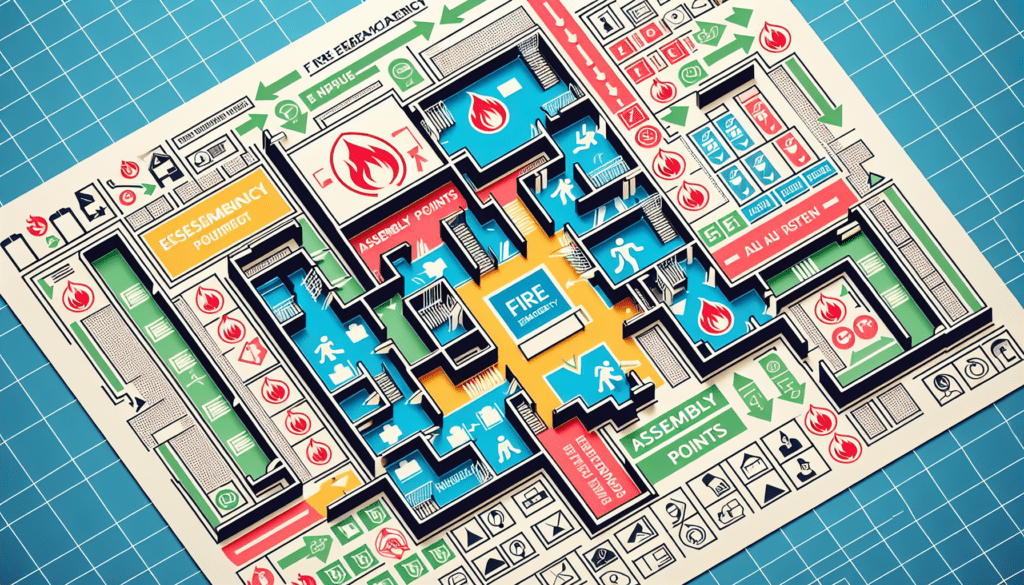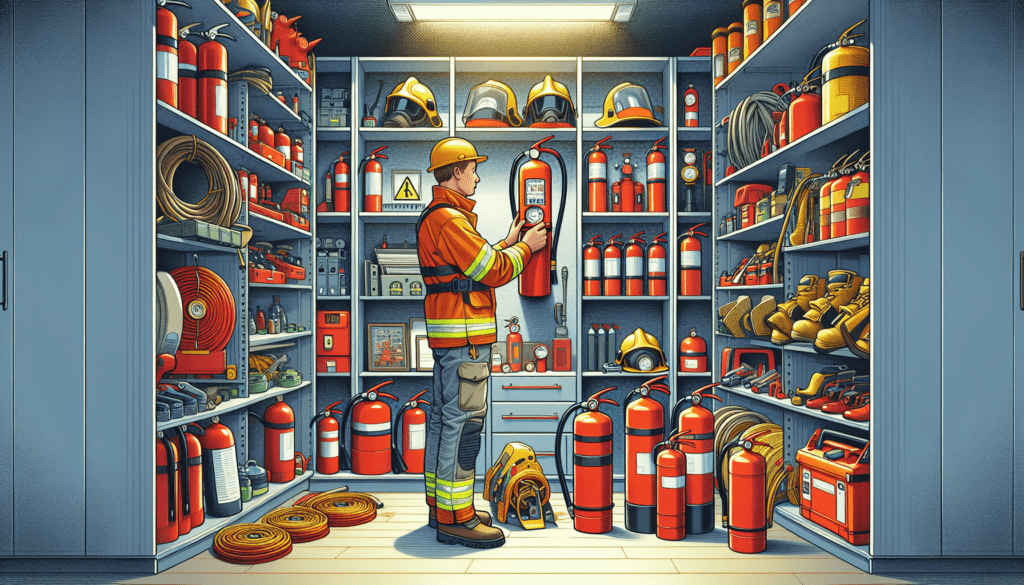- Key Takeaways
- Understanding a Fire Emergency Evacuation Plan
- Developing Your Fire Evacuation Strategy
- Roles and Responsibilities During an Evacuation
- Communication and Alarm Systems
- Special Considerations for Personal Emergency Evacuation Plans (PEEPs)
- Coordination with Emergency Services
- Post-Evacuation Procedures
- Maintaining Fire Safety Equipment
- Legal Requirements and Compliance
- Summary
- Frequently Asked Questions
A fire evacuation plan is essential for ensuring everyone’s safety during a fire emergency. A crucial component of this plan is the fire warning system, which provides clear signals or voice messages to alert occupants of the need to evacuate or to remain calm, depending on their proximity to the fire. It details the steps to take and who to contact, so employees can evacuate safely. This article will guide you in understanding, creating, and implementing an effective fire evacuation plan for your workplace.
Key Takeaways
- Implementing a comprehensive Fire Emergency Evacuation Plan (FEEP) is vital for ensuring workplace safety during fire emergencies, outlining clear escape routes and procedures.
- Regular training, updates, and reviews of fire evacuation strategies are essential to enhance preparedness and comply with legal requirements under the Regulatory Reform (Fire Safety) Order 2005.
- Effective communication systems, including alarm and emergency lighting, alongside designated roles for staff, play a critical role in the successful execution of fire evacuations.
Understanding a Fire Emergency Evacuation Plan

A written document that details the procedures employees must follow in the event of a fire and stipulates methods for alerting the fire brigade is known as a fire emergency evacuation plan. It aims to guarantee everyone’s safety by delivering explicit directions and executing an orderly departure from the location at risk. Such plans should be drafted by those accountable within a workplace, incorporating recommendations from reputable entities such as the Fire Safety Advice Centre.
This evacuation plan delineates requisite steps during an emergency involving fire, with its chief objective being to ensure all individuals are well-informed about appropriate reactions, thereby promoting an efficient and organised escape process. In this regard, it is essential that employees have access to up-to-date information regarding fire safety along with unequivocal guidelines pertaining to emergencies.
Key Elements of an Effective Fire Evacuation Plan
To develop an efficient emergency evacuation plan in the event of a fire, certain crucial components must be included:
- It is imperative to clearly designate key escape routes and ensure they are as concise and straightforward as can be achieved, with emphasis on principal escape routes.
- Emergency exits and pathways need to accommodate the volume of individuals requiring safe passage, with all emergency doors designed for ease of opening during such evacuations.
- Floor plans should elucidate vital details like escape paths, locations of fire alarms, and assembly points to bolster successful evacuation efforts.
Proper training regarding egress procedures should be provided to every employee along with routine drills aimed at heightening readiness for assorted emergent situations. Allocating specific duties amongst personnel is key in executing a swift evacuation by facilitating prompt action and proper utiliation of resources.
Importance of Regular Updates and Reviews
Regularly revising the fire evacuation plan is crucial for maintaining adherence to safety standards. The enhancement of the plan’s efficacy should reflect learnings from previous evacuation outcomes.
Improvement identification in the fire evacuation strategy bolsters readiness for potential future emergencies.
Developing Your Fire Evacuation Strategy

It is essential to customise a fire evacuation plan that addresses the unique risks present in your workplace. To adhere to safety regulations, companies must carry out a fire risk assessment.
Such assessments form the foundation for creating an effective evacuation strategy that meets the requirements of the Regulatory Reform (Fire Safety) Order 2005.
Simultaneous Evacuation Procedures
Upon the triggering of a fire alarm, it is imperative that every individual on the property promptly vacates in what is known as a simultaneous evacuation. This method is direct and aims to expedite the process of clearing out occupants to diminish any potential threat to their safety.
The initiation of either a simultaneous or phased departure can be signalled through a universal alarm sound.
Phased Evacuation Techniques
In substantial structures, implementing phased evacuation methods enhances safety by avoiding overcrowding and bottlenecks during an emergency. The vertical phased approach prioritises the immediate clearing of zones nearest to the fire, progressing systematically to subsequent areas. Such a strategy is instrumental in regulating pedestrian traffic efficiently and mitigating panic risks.
Conversely, horizontal-phased evacuations focus on methodically vacating occupants level by level instead of en masse. To maintain efficacy and ensure that they are up-to-date with any changes within the organisation, it’s imperative to periodically reassess these fire evacuation strategy actions.
The adoption of these techniques plays a vital role in executing secure fire emergency evacuation procedures across various situations, ensuring orderly egress from danger zones when necessary.
Defend in Place Strategy
The strategy of defending in place is appropriate for environments like hospitals and nursing homes, where prompt evacuation may not be practical. In this approach, individuals stay where they are until assistance reaches them. It’s crucial to engage with a knowledgeable individual as well as the fire service before putting this strategy into action.
It requires meticulous deliberation to assess whether it’s safer for occupants to remain stationary or attempt to move, given the risks involved.
Roles and Responsibilities During an Evacuation

It is imperative for an effective response to understand the duties and tasks of each individual during an evacuation. The responsibilities and roles should be explicitly defined within the evacuation plan so that all parties are aware of their obligations.
Such clarity in defining these roles is essential to guarantee that the execution of the evacuation plan proceeds smoothly when faced with emergency situations.
Fire Wardens and Marshals
It is essential for fire wardens, also known as marshals, to play a pivotal role in enforcing fire safety protocols, orchestrating evacuations effectively, and keeping track of personnel during an incident involving fire. The principal fire warden bears the responsibility of managing the execution of these safety measures and certifying adherence amidst crisis situations. Assigning individual wardens to designated zones with backup deputies will facilitate efficient operation.
To standard employee training programs, specialised instruction is imperative for these fire wardens and marshals, which includes learning how to handle extinguishers properly along with acquiring comprehensive knowledge on preventing fires. Their duties encompass upholding stringent precautions against fires while ensuring that everyone in the workforce comprehends the procedures outlined within the evacuation plan.
Staff Training and Drills
Every employee needs to be proficient in using escape routes, as necessitated by fire safety protocols. Under the Regulatory Reform (Fire Safety) Order 2005, it is imperative for designated responsible individuals to carry out fire risk evaluations and guarantee that all employees receive sufficient training. To ensure everyone, including those who require aid during an evacuation and the team assisting them, are well-versed in Personal Emergency Evacuation Plans (PEEP), regular practice drills should be conducted.
Maintaining detailed records of fire safety instruction and practice evacuations is crucial for adhering to regulatory standards. Such records serve as a tool to monitor advancements in fire safety preparedness and pinpoint specific areas where improvements are needed.
Communication and Alarm Systems
During a fire emergency, the utilisation of effective communication and alarm systems is crucial for coordinating an expedited and structured departure. The implementation of public address and voice alarm systems improves the efficacy of evacuation by providing unmistakable verbal directions.
By integrating these systems, every individual present in the building is promptly informed of essential details that aid in executing a more efficient evacuation process.
Fire Alarm Systems
Fire warning systems come in a spectrum from those necessitating human intervention to fully automated ones that offer extensive protection. Contemporary fire alarm systems possess the capability to autonomously activate warnings after a set time period, providing prompt notification regardless of whether manual initiation occurs or not. Such systems bolster security protocols across different settings.
Voice evacuation alarms have been shown to expedite egress times substantially, as individuals are 75% more inclined to heed spoken instructions compared with conventional alarm sounds. This heightened propensity for adherence can be pivotal during critical situations.
Emergency Lighting and Signage
Illumination during emergencies is vital as it directs people towards exit paths when visibility is compromised by smoke or the absence of electricity. Lighting up escape routes promotes a secure and structured departure from dangerous situations.
Well-defined and thoughtfully positioned signs are key in steering building occupants to safety amidst crises. Signs that clearly mark exits and emergency procedures aid in minimising disorientation and alarm, enabling a swifter and more secure egress.
Special Considerations for Personal Emergency Evacuation Plans (PEEPs)

It is critical for individuals who might need aid in an evacuation during emergencies to have a personal emergency evacuation plan (PEEP) tailored to their unique requirements. This emergency evacuation plan should encompass the particular necessities of employees or guests with mobility difficulties or other disabilities, ensuring they can evacuate safely.
Identifying Individuals Needing PEEPs
Individuals with disabilities or sensory impairments, as well as those temporarily impaired due to injuries or medical conditions, may require specialised aid when an evacuation is necessary. Groups dedicated to the representation of these individuals can offer insights into their unique requirements.
For the purpose of creating Personal Emergency Evacuation Plans (PEEPs) that cater specifically to each person’s needs during a crisis, it is essential to thoroughly record these identified necessities. This meticulous documentation guarantees that all individual needs are addressed appropriately in emergency situations.
Crafting Effective PEEPs
Organisations that represent different disability communities can offer crucial advice and perspectives for the creation of PEEPs (Personal Emergency Evacuation Plans), which need to be customised to meet the unique requirements of each person.
Coordination with Emergency Services
A crucial component of an emergency evacuation plan in the event of a fire is establishing communication with local emergency services. This alignment allows those responding to emergencies to receive critical information that facilitates prompt and efficient action.
Informing the Fire Brigade
It is imperative that the fire brigade be notified instantly, either by the person who finds the fire or by a switchboard operator. Relaying critical information regarding the location and characteristics of the fire will guarantee an efficient reaction from the fire brigade.
Liaison Roles
Upon the arrival of emergency services, designated liaison officers are tasked with ensuring effective communication. They must be capable of relaying vital information and maintaining ongoing contact with the individual overseeing the roll call at the fire assembly point.
Inter-Agency Liaison Officers (ILOs) play a critical role in providing strategic guidance and may take on command responsibilities when required in urgent situations. During an emergency evacuation, it is the duty of the appointed senior person to interface with fire and rescue personnel, offering them all necessary details.
Post-Evacuation Procedures
During a fire emergency, maintaining control and ensuring accountability following the evacuation are vital. This includes tallying individuals at designated assembly points to confirm everyone’s safety and reviewing the efficacy of the evacuation procedures to pinpoint potential enhancements.
Assembly Points and Roll Call
Assembly points are predetermined safe spots where evacuees converge and enable the execution of roll calls. The individual tasked with performing the roll call at these assembly points should be the designated contact person in an evacuation scenario.
Such locations guarantee that every individual is accounted for following an evacuation.
Evaluating the Evacuation
Ensuring safety in the event of a fire emergency hinges on the efficacy of your evacuation strategy. Post-evacuation, it is vital to solicit feedback to evaluate how well procedures worked and pinpoint opportunities for enhancement.
The overarching goal of your fire evacuation plan must be the safe and swift departure of all individuals involved.
Maintaining Fire Safety Equipment

Ensuring that fire safety equipment is consistently maintained guarantees its operational effectiveness in the event of an emergency. Routine upkeep not only prevents potential dangers, but also secures its state of readiness for any fire-related incidents.
Fire Extinguishers and Other Equipment
It is imperative to conduct routine inspections of fire extinguishers and related safety gear to confirm their functionality and preparedness for urgent situations. Keeping detailed logs of drills and tests conducted on equipment is crucial for meeting fire safety regulations.
Ensuring the dependability and performance of fire safety apparatus in emergency scenarios requires consistent verification, including adherence to basic fire safety protocols. This involves confirming that all necessary equipment remains operational and readily available when needed.
Fire Door Inspections
To guarantee compliance with safety standards and proper functionality in emergency situations, fire door inspections should be conducted consistently. It is essential to thoroughly examine these doors for any harm that might hinder their capability of confining a fire, including looking for seals that are absent or mechanisms that have become stuck.
It is imperative to carry out frequent examinations on fire doors to verify they shut correctly without sustaining damage. Such assessments play a vital role in upholding the integrity of compartments designed to resist fire, effectively curbing the propagation of both flames and smoke.
Legal Requirements and Compliance
It is imperative for every business to formulate a detailed Fire Emergency Evacuation Plan (FEEP) that outlines the required procedures in case of a fire. For the assurance of safe evacuation, UK law mandates employers to implement and adhere to effective safety strategies.
Neglecting the inspection of fire doors may lead not only to monetary fines but also to potential incarceration.
Regulatory Reform (Fire Safety) Order 2005
The 2005 Regulatory Reform (Fire Safety) Order establishes guidelines for fire safety in the workplace. It is mandatory for companies to align their fire evacuation strategies with this order, as failure to do so may result in legal ramifications, monetary penalties, and heightened responsibility should a fire occur.
To preserve a secure setting continuously, it’s crucial that businesses conduct frequent assessments of potential fire hazards and revise their evacuation schemes when needed. This will ensure adherence to regulations regarding fire safety measures over time.
Documentation and Record-Keeping
It is crucial to meticulously document the outcomes of fire training, as this plays a key role in ensuring compliance and preparing for emergencies effectively. This documentation should encompass tracking the progress made during training sessions, recording fire drill practices, and monitoring equipment testing procedures. Such records are vital for pinpointing areas that require enhancement in terms of fire safety measures.
Summary
To sum up, it is imperative for the protection of both employees and guests in any workplace to have a well-formulated fire emergency evacuation plan. This involves acknowledging essential components of an efficient evacuation strategy, consistently revising and amending the plan as necessary, creating bespoke exit tactics suitable for various scenarios, and keeping all fire safety apparatus in check. The primary objective here is safeguarding individuals’ well-being and company assets. Hence, thoroughly preparing a robust emergency evacuation plan is the pivotal measure toward this end.


